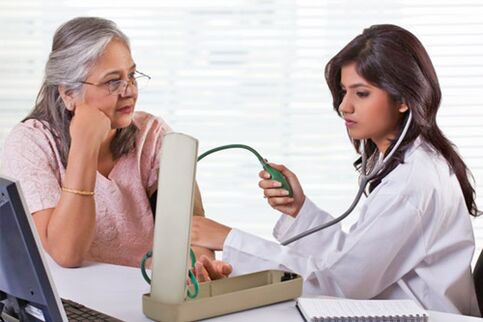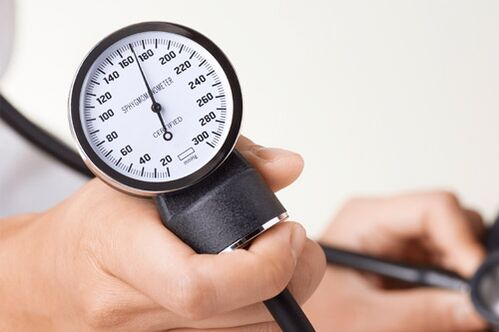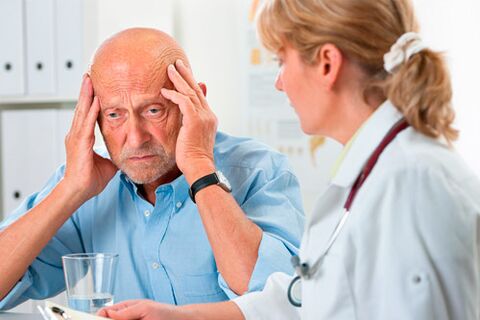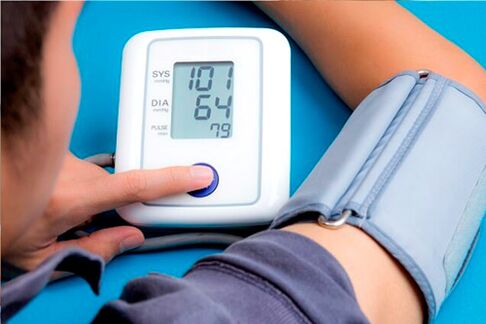Age-related characteristics, extrinsic and intrinsic factors, changes in hormonal levels, bad habits, and psycho-emotional factors at different times in a person's life can all affect changes in blood pressure and lead to increased blood pressure. People don't always see their doctor on time, so high blood pressure is permanent. This article will describe the symptoms of high blood pressure and how it differs from low blood pressure.
preliminary performance

Hypertension is characterized by changes in the morphology of blood vessels that affect a person's overall health. To understand whether a person has high blood pressure, and what symptoms characterize this pathology, you need to know the easiest ways to self-diagnose to help you properly deal with jumps in markers and prevent complications.
Hypertension is one of the most common diseases. Hypertension occurs in one in three people and is characterized by high mortality in severe stages. Only a complex treatment that combines medication and maintaining a healthy lifestyle can be successful.
Hypertension is characterized by a gradual, long-term, slow course initially characterized by the absence of severe symptoms. Under high pressure, the presence of disease can be indicated by periodic symptoms including:
- occipital or temporal pain;
- Dizziness;
- hearing loss, tinnitus;
- blurred vision;
- Tachycardia and chest pain;
- nausea and gag reflexes;
- feeling short of breath;
- anxiety;
- irritability;
- sweating or chills;
- Repeated nosebleeds.
A person experiencing at least one of the above symptoms of high blood pressure (probably the first) is a reason to see a family doctor or therapist for diagnostic and preventive purposes, because the disease in an advanced, untreated state can cause myocardialHorrible complications like infarction and ischemic stroke.
symptom characteristics
Arterial hypertension always disappears with headaches in the back of the head or temples, which can be well stopped by analgesics at the onset of pathological development. Its occurrence is related to changes in the narrowing direction of the cerebral vascular lumen. People with hypertensive headaches describe it as a dull pain or cramp in the back of the head with sharp, stabbing, throbbing in the temples.
Tinnitus and hearing impairment in high blood pressure may be caused by a malfunction of the hearing aid's blood vessels.
important! A sudden onset of pain in the head is a direct indicator of stress.
Vision deterioration in hypertensive patients, manifested by the appearance of double flickering dots (flies) in the eye, is associated with insufficient blood supply to the retina and impaired optic nerve function.
Nausea and gag reflexes are responses to attacks of headache and dizziness, while manifestations of frequent heartbeats and retrosternal pain are caused by dysfunction of the pulmonary circulation vessels. A feeling of lack of air (shortness of breath) is characteristic of high blood pressure and is more common in obese people of any age.
The frequent occurrence of hypertensive symptoms can lead to a hypertensive state. Then, facial skin congestion, anxiety, heart pain will join the above pathological signs. This condition does not go away on its own and requires emergency treatment.
important! Periodic symptoms of high blood pressure will prompt the patient to consult a doctor and initiate treatment. The asymptomatic course of the disease robs a person of precious time.
Tonometer indicator
To understand if stress increases, it is necessary to measure the indicators regularly with a tonometer in different conditions (happiness, poor) and to understand their norms.
The standard value is considered to be 120/80 mm Hg. Art. The 10-unit range of these numbers is not bias. Signs of increase above 140/90 mmHg. Art, combined with headaches, nausea, and heartache, is considered a symptom of arterial hypertension.
important! A person's stress is always individual, it depends on physical and external causes. "Working" tones - these are blood pressure values that the patient feels good about. Hypertensive patients know their normal values and control them by taking the antihypertensive drugs chosen by the attending physician in a timely manner.
characteristics of pathological degree
The signs of hypertension depend directly on the level of the index, among which there are 3 types of hypertension, which can be expressed in the form of a table:
| degree of high blood pressure | Shrinkage Index (mm Hg) | Diastolic blood pressure (mm Hg) | Main symptoms of high blood pressure |
|---|---|---|---|
| 1 degree | 140-160 | 90-100 | They are characterised by a cyclical rise through the absence of a clear clinic, with a rapid return to normal. Dizziness, insomnia, heavy head, and positioning of the back of the head are rarely noticed. |
| 2 degrees | 160-180 | 100-110 | Intense occipital or temporal pain accompanied by nausea, dizziness, weakness, and insomnia. |
| 3 degrees | Up to 182 and above | over 110 | Unbearable headache (especially in the morning), nausea, vomiting, ringing in the ears, visual disturbances, shortness of breath, sweating, tachycardia, swelling of the lower extremities, thirst, urinary disorders. |

The clinical symptoms of initial hypertension may be mild. For a long time, a person may not even be aware of the increase in pressure in the vessel and the development of the process. The early and first signs of high blood pressure are increased irritability and fatigue for no apparent reason.
Hypertension Symptoms of degree 2 and 3 hypertension with a systolic blood pressure reading of more than 160 mm. Causes a hypertensive crisis, characterized by distinct head pain, nausea, vomiting, blurred vision (fog, shroud) or a feeling of flickering dots of varying nature, as well as: tremors in the extremities, rapid pulse, feeling short of breath, heartache, Arrhythmia, loss of consciousness.
What is arterial hypertension - all hypertensive patients know. In the first emergency, it is useful to know how to help yourself or a loved one before the ambulance arrives:
- Place 1 tablet of validol or nitroglycerin under the tongue.
- Air channels are arranged, tight clothing is removed, and the patient is kept in a high position on the bed (elevated on the pillow).
- Apply the mustard paste to the calf muscles.
- Add 30 drops (1 tablespoon) of valerian, motherwort in alcohol solution.
- Take any pain reliever for head pain and lubricate whiskey, forehead, neck and behind ears with peppermint oil.
- You can soak your feet in hot water for 15 minutes.
In addition, doctors recommend doing a simple exercise to restore breathing. For this, it is recommended to take a deep breath, hold your breath, and exhale very slowly. This should be done 3 to 5 times. In this case, the position of the body should be inclined.
important! If a patient with hypertensive crisis is not given timely help, he may suffer a stroke or myocardial infarction. Since grades 2 and 3 are incurable, the patient must constantly manage the increase in stress.
age characteristics
Increased stress in people over 50 is often associated with initial problems with heart and blood vessel function, atherosclerosis, anemia, hyperthyroidism, and impaired kidney function. Shortness of breath, significant leg swelling, and cardiac arrhythmia may occur. Women are more likely to get sick than men.
The symptoms of high blood pressure are always due to age-related changes in the blood vessels, causing them to lose their elasticity. In addition to the typical clinical features of hypertension, intermittent claudication, frequent fainting, dizziness when changing positions, head noise, and retrosternal pressure pain may also increase. There is also general malaise, decreased performance and weakness.
Symptoms of teenage hypertension can begin at age 12 (adolescence) and continue until age 17, as the growth of indicators can occur in people of different ages. This is due to the reorganization of the body and changes in hormonal metabolism. Characteristic signs of elevated blood pressure in adolescents are increased sweating, rapid heartbeat, ringing in the ears, dizziness, headache, insomnia, hot flashes on the facial skin, and epigastric discomfort.
important! To ensure that vascular lesions may occur in this particular case, it is necessary to measure the pressure in the body several times in a row, preferably every 15 minutes. These metrics should be recorded and ensured to be reported to a physician for appropriate treatment. Which medicines to take - the doctor will decide.

If you notice multiple symptoms accompanied by an increase in blood pressure, you need to consult a doctor, carry out an examination and determine the real cause of this pathology: tumor, kidney, endocrine, vascular disease. Therapists, neuropathologists, and family physicians will prescribe appropriate treatment based on diagnostic data, physical functional characteristics, age group, co-morbidities, and allergy predispositions.
For hypertension, epinephrine blockers, diuretics, ACE inhibitors, slow calcium channel blockers are prescribed.
Applied Physiotherapy - Electrosleep; Magnetic Therapy; Ultra High Frequency Therapy; Infrared Laser Therapy, and Traditional Medicine. Hypertensive patients are advised to pay attention to their diet and eat enough fruits and vegetables.
important! Preventive measures to prevent vascular lesions and the development of hypertension include timely physical examination, normalization of work and rest, dietary moderation, combating excess weight, prevention of stressful situations, use of adequate amounts of water, vegetables, fruits, and elimination of dependence on nicotine and alcohol (if so).
The difference between high pressure and low pressure
In addition to signs of high blood pressure, in which rates may increase, there is also a manifestation of low blood pressure, called hypotension.
Periodic drops in pressure are characterized by indicators below 101/66 mm Hg. Art. It all depends on the age group, so the numbers may vary.
Although both low blood pressure and high blood pressure can cause unbearable paroxysmal headaches, as the pressure decreases, the following symptoms that distinguish high pressure from low pressure appear:

- Bad health, weak body. From the morning, the patient feels weak and unwell.
- Limbs are cold. Hands and feet are always cold.
- Noise in the ear (periodic presence).
- Unpleasant sensations in the heart area, tachycardia. Every patient has their own feelings.
- Dizziness and frequent darkening of the eyes (sometimes diplopia). This symptom is not only characteristic in the morning, but also in the daytime.
- Drowsiness during the day, sleep disturbance at night. During the day, the patient feels the need to sleep all the time. Peak activity starts in the evening. Sleepless nights, light sleep.
- Digestive problems. People with low blood pressure often have gastritis, liver problems, constipation, indigestion, and dysbacteriosis.
The above characteristic symptoms are more common in young people, most of whom are women. Causes of lower blood pressure are stress, lack of sleep, poor lifestyle, lack of vitamins, use of a strict diet, hormonal disturbances, intense physical and mental stress, certain physical diseases (endocrine, cervical osteochondrosis, liver, kidneys, VVD, sedentarylifestyle). Long-term depression may be the main cause of low blood pressure.
The first "bells" about how low blood pressure begins to develop occurs when a person wakes up heavily in the morning, feeling overwhelmed, irritable, and sleep deprived. After a while (everyone is a pure individual), headaches appear and don't go away until lunch.
Here, the common symptoms of hypertension are nausea, vomiting, weather dependence and fainting, which is a long asymptomatic course. You can increase low blood pressure by taking special medications, dietary treatments, herbal remedies, and maintaining a healthy lifestyle.
treat
Medications that increase blood pressure include Acanthopanax senticosus or ginseng tinctures, special medicines. Caffeine has the same effect.
Herbs include decoctions and infusions of herbs extracted from plants such as St. John's wort, lemongrass, ginseng, immortelle, tartar, ginger, and more.
In hypotensive patients, low-dose alcohol consumption is acceptable. A glass of red wine or 25 grams of brandy a week is good for the body: it dilates blood vessels and improves circulation. A cup of coffee in the morning brings a good mood.
People with hypotension should maintain adequate sleep to stay awake (more than 8 hours per day), be adequately active, eat a balanced diet, and engage in moderate exercise (morning exercise, swimming, aerobics, yoga, outdoor exercise), contrast flushing showers, alternatingmassage.
important! Untreated low blood pressure can turn into high blood pressure after age 40.
Anyone is advised to monitor their blood pressure levels carefully. It is necessary to use the tonometer in a calm state after sleep and before night, good or bad health. It is better to record all the indicators, compare and determine "your" stress, in these indicators the best work capacity and life activities are recorded.
If the increased number persists for a long time, you should definitely consult your doctor to protect yourself from future fatal complications. healthy!



























